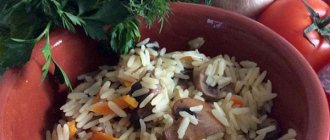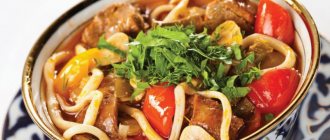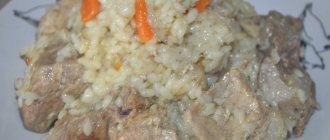Many peoples of Central Asia argue which of them belongs to the primacy in the invention of pilaf. Now it is impossible to determine where this dish originated. Another thing is important: as it spread around the world, pilaf acquired a lot of regional characteristics. It is prepared in Turkish, Uzbek and even Indian. Sometimes... no rice at all. The cereal part can be pearl barley, wheat, corn or peas. Lamb is also not always a required ingredient. It is often replaced with beef, pork and even fish. The process of preparing pilaf also varies greatly depending on the region. In Central Asia it is made in large cauldrons over an open fire, in other countries it is simmered in the oven or fried in a frying pan. But what is an essential component in the dish is seasonings. For pilaf they are decisive. Without them, you will just end up with rice porridge with meat. Seasonings are the philosophy of the dish itself, and here we will try to reveal and explain it.
Triumvirate
Ingredients for pilaf can be grouped into the following categories. The first is the saturating part. These are cereals (usually devzira rice) and meat (lamb from both old and not young animals). The second category consists of refreshing vegetables. The canon requires adding carrots, onions and garlic to pilaf. Various deviations from the classics allow you to prepare a dish with dried fruits - raisins, dried apricots, dates. Well, the third component is seasonings. They are the ones who give the fatty dish its aroma, spiciness and taste. Spices also serve as natural preservatives. In hot southern climates, meat quickly disappears and cooked rice becomes sticky. Spices allow you to not feel hungry for a long time. They are also responsible for burning excess calories. What seasonings are needed for pilaf? Under no circumstances should you pour everything you can find in the house into the dish. But there is no firm canon on this issue. We can only highlight the directions that should be followed if you want to get Uzbek, Turkish or some other pilaf.
How to cook pilaf
The classic composition of the spice seasoning is as follows:
- Seasoning for pilaf cumin (also known as cumin). It is this component that is the main one and gives a unique smell and taste;
- Barberry is used to neutralize fat and adds sourness;
- Garlic enhances the taste and gives an appetizing aroma;
- Saffron (you can take turmeric) is the same yellow seasoning for pilaf that turns rice golden. As you understand, saffron and turmeric are not the same thing; many people sometimes confuse these seasonings.
No less important is the question of when to add spices to pilaf. Experts recommend adding ground seasoning before the rice boils. Let's move on to recipes for dishes with different types of meat and discuss each of them in detail.
The composition of the seasoning for pilaf changes for each housewife - you can add or remove ingredients at your discretion. We offer you an easy way to prepare seasoning for pilaf at home - but we do not recommend storing them for a long time.
- Thinly slice the head of garlic;
- Add one teaspoon each of turmeric, paprika, barberry and cumin;
- Add a tablespoon of suneli hops and a pinch of dried herbs;
- Mix well.
Finally, we note that you can buy ready-made seasoning for pilaf at the market or in a store - they sell both ready-made mixtures and all the herbs separately.
Study the review, get inspired and start culinary experiments - we promise you that soon you will be able to enjoy the unique taste, aroma and oriental flavor!
The basic principle of pilaf is this: first, zirvak is prepared (this is meat and vegetables fried in oil with spices and broth), and then rice is poured on top.
Heat a cauldron and pour oil into it. It should warm up well so that later the ingredients can quickly brown.
Next, the onion or meat is fried. If you are preparing pilaf with a lot of onions, you can fry the meat first. Place it in the cauldron gradually so as not to reduce the temperature, and do not turn it over immediately - otherwise it may begin to release juice.
Fry the onion until golden brown so that the finished broth gives color to the rice.
Chicken pilaf differs, for example, from lamb pilaf in lower fat content. Chicken is tender meat with its own interesting taste and aroma. For this reason, less spices are put into pilaf with chicken.
- Ground black pepper;
- Hot red (fresh or dried);
- Parsley (dried or fresh);
- Zira in grains.;
- Barberry (red or mixed with black);
- Ground thyme;
- Saffron can be replaced with turmeric.
You can use the same seasonings for turkey pilaf.
European and Asian schools
Local tastes and available products played a role in the fact that a dish like pilaf acquired a lot of regional characteristics. Fat-tailed sheep, the fat of which is used in Central Asia, is not common in Europe. In India they like to add saffron to dishes. Turks love pilaf with sultanas and dates, figs or dried apricots. Europeans like the more neutral taste of the dish, not as hot as in Asia. Therefore, seasonings for pilaf can be classified into two large groups. A classic of the genre, born in the fertile valleys of the Syr Darya and Amu Darya, it requires adding cumin and barberry to the dish. The European school generously uses herbs (they are added to ready-made pilaf), black allspice and sweet paprika.
Pilaf with barberry and cumin
- you need long-grain steamed rice (about 300-350 grams);
- chicken loin – 300-370 grams;
- one third of an average sized onion;
- garlic (to taste);
- medium-sized carrots (not all of them can be used);
- unrefined vegetable oil (the aroma of the oil is very important);
- table salt, spices (barberry, cumin);
- a leaf of fresh herbs (optional).
- 1Soak the rice for several hours. Prepare carrots: wash, peel, grate;
- 2After peeling, cut the onion and garlic into small pieces;
- 3In a preheated pan, fry the spices for two minutes;
- 4 Add carrots to the spices and start sautéing;
- 6 Divide the chicken meat into medium-sized pieces;
- 7Place the meat in a pan with vegetables. Fry, stirring;
- 8Drain excess water from rice. Then rinse it well. Pour into a saucepan with meat and vegetables, stir the mixture;
- 9Pour water into the pan. So that it hides the rice. Add salt. Cook until done. Then place it nicely on a flat plate.
It's no secret that every chef adds his own twist to a dish. Which is completely justified. This is how he wants to take care of his guests. This recipe also has its own tricks. Less oil for a lighter dish. Plus the right spices. Which turn ordinary rice into oriental pilaf.
Pre-soaked rice will significantly reduce the cooking time of the pilaf. There is no need to constantly add water and oil to the pan. Because dry rice takes a long time to cook, and liquids constantly boil away and are absorbed. Significantly weighing down the finished dish.
This is a traditional recipe that involves using lamb. However, if this meat is not to your taste, you can use pork. Prepare the following products:
- 1 kg of meat;
- 1 kg of rice;
- 4 onions;
- 1 kg carrots;
- 2 heads of garlic;
- 2 pods of hot dry pepper;
- 1 tbsp. l. cumin and barberry;
- 0.3 liters of sunflower oil;
- 1 tsp. coriander seeds;
- salt.
Wash the rice and add warm water. Cut the meat into cubes. Cut 3 onions into half rings, carrots into strips. Remove the skins from the garlic, but do not let the cloves fall apart.
Place 1 unpeeled onion in hot oil, fry until black and discard. Fry the peeled onion in this oil, then add the meat. When it is crusty, add the carrots and fry without disturbing for 3 minutes. After this, fry for another 10 minutes. stirring.
Place grated coriander and cumin, as well as barberry, into the cauldron and add salt. Simmer until carrots are soft. Add boiling water 2 cm above the main mass and pepper. Simmer for 1 hour. Add rice, add more water if necessary. Press the garlic into the rice. Don't interfere! Cook until the rice is done.
The recipes described above are quite suitable not only for everyday, but also for holiday menus. In addition, the dish will be especially tasty if it is cooked not on the stove, but in a cauldron over an open fire. Therefore, you can try cooking pilaf at the dacha or on a picnic.
Where to buy seasonings
In stores you can often find packages with a mixture of spices. They are called: “Seasoning for pilaf.” The composition of such a bag is close to the Central Asian standard. Except for one “but”: the spices must be fresh. And in the package they could lie for more than one year. It is better to purchase a ready-made mixture from market traders - preferably people from Central Asia. They will definitely ask you what kind of pilaf you prefer - fragrant, spicy, saffron-colored? Experts will select the optimal composition for you so that you get a dish balanced in taste and aroma. But in any mixture there will definitely be three canonical spices: cumin, dried barberry and red pepper.
Set of ingredients for seasoning
The classic composition of seasoning for pilaf with lamb, beef or pork looks like this:
- 1.5 tbsp. l. ground herbs (dill, parsley, cilantro);
- 1 tbsp. l. dried garlic;
- 1 tsp. saffron or turmeric;
- 1 tbsp. l. khmeli-suneli;
- 1 tsp. paprika;
- 1 tsp. cumin;
- 15 g barberry.
The components are mixed in a dry container.
If necessary, you can grind them again using a coffee grinder.
Another option, which is suitable for pilaf made from any meat, is prepared on the basis of crushed dried tomatoes. Take 1.5 tbsp. l. tomatoes, 2 tbsp. l. chopped herbs and a handful of raisins. Add 0.5 tsp to them. curry, 0.5 tsp. rosemary and 15 g of barberry berries. You can also add 1.5 tsp. paprika, the same amount of turmeric and 1 tsp. cumin.
Saffron
These dried flower stigmas, ground to red threads, are sometimes added to seasonings for Uzbek pilaf. Plants of the iris family are very rare, and therefore this spice is an expensive pleasure (a thousand dollars per kilogram of flower pistils!). Therefore, a more affordable option would be turmeric powder (30 rubles per 20 gram package). Its properties are similar to saffron. Turmeric can also color rice yellow, give the pilaf the aroma of orange and pepper, and add heat to the taste. But you need to sprinkle the spice very carefully - on the tip of a knife. If you overdo it, the whole dish will be very bitter.
Saffron can be purchased not only in the form of threads, but also in powder. Special gourmets prefer to buy fresh flower stigmas. Saffron water is made from them so that the pilaf is evenly colored. The stigmas are ground in a mortar to a powder. Pour boiled water over it for a day. Then filter through cheesecloth. Unlike other spices, saffron water is added after adding rice.
What seasonings are put into Uzbek pilaf?
Uzbek pilaf is the greatest achievement of Uzbek cuisine. Today there are a huge number of variations in the preparation of this dish. And for each type of this pilaf you can use completely different seasonings and spices.
- Seasoning for Uzbek pilaf “Kotanyi” is perfect for such a dish. The ingredients include cumin, black and chili pepper, barberry, coriander and salt. You can also see celery and sesame in the composition. A package weighing 25 g is enough to prepare pilaf with 1 kg of meat. The seasoning is distinguished by a persistent and pronounced cumin aroma.
- You can also use ready-made seasoning for pilaf from the Omega brand. This seasoning consists of coriander, turmeric, cumin, cumin, salt, paprika and garlic. By adding this spice to your dish, you will get pilaf with a pronounced aroma of garlic, and the color of the dish will delight you with a golden tint.
- Another seasoning with interestingly selected ingredients is pilaf seasoning from the Spice brand. The composition of this seasoning is slightly different: bay leaf, cinnamon, ginger, cloves, nutmeg, green cardamom, black pepper and chili, salt and, of course, cumin. The combination of such spices will give your pilaf an incredible smell and taste. For 500 g of meat and 500 g of rice you need to take 1 tbsp. l. this seasoning.
Dried tomatoes for pilaf
You can also add to Uzbek pilaf:
- Dried tomatoes
- Saffron
- Raisin
Seasoning for pilaf: cumin
These are the seeds of cumin, or Asian (Indian) cumin. Zira differs from those seeds that we add to rye bread in its darker color and small size. If you decide to buy cumin separately, at the market, make sure that unscrupulous traders do not slip you carrot seeds instead of the spice - they look very similar. But cumin has an amazing smell. Just rub the seeds in your fingers - the possible deception will immediately come out. For pilaf, it is best to use whole seeds. They are added to “zirvak” - we’ll tell you what it is later.
Seasoning and spices for beef pilaf: names, composition, proportions
Beef in pilaf can be called a traditional product. Using this ingredient, the pilaf turns out to be unusually rich and has a specific taste.
The following seasonings are suitable for beef pilaf:
- Seasoning for aromatic pilaf from the Knorr brand does not contain preservatives or dyes. In the composition you can see carrots, onions, vegetable fat, cumin, of course, salt and sugar, as well as barberry, cumin, red hot pepper, black pepper, turmeric, coriander and thyme. One package is enough to prepare pilaf from 140 g of rice and 400 g of meat
- You can also use the already well-known seasoning “Pripravych” for beef pilaf.
Seasonings for pilaf with beef
Well, and, of course, add some spices for the beef:
- Shambhala or fenugreek
- Marjoram
- Oregano
- Savory
- Sumac
Barberry
Mandatory seasonings for Uzbek pilaf include black berries. If cumin is responsible for the aroma, then barberry softens an overly fatty dish with a pleasant sourness. Uzbek pilaf masters recommend buying Central Asian dried grains – black. But both red and burgundy barberry are available for sale. The color of the berries does not have much influence on the taste. Barberry, like cumin, does not need to be ground in a mortar. When you bite into a whole berry in pilaf, you will be pleasantly surprised by the sour, almost apple-like taste. This barberry is a storehouse of vitamin C. They also put it in “zirvak”.
How to add seasoning correctly
To prepare good pilaf, it is not enough to know what is included in the seasoning. It is important to maintain the correct proportions of adding the mixture to the dish. The calculation is made depending on the amount of meat. So, if pilaf is prepared from 1 kg of meat, then 1/3 tablespoon of the mixture will be enough to give a weak taste. 2/3 of a spoon will make the taste more pronounced, and a whole tablespoon will give the pilaf a strong richness.
INTERESTING FACT! Different cooks add spices to pilaf in different ways. Some people put spices three times: on meat, on carrots and on rice. Others only once, when the meat is sufficiently cooked.
What you definitely shouldn’t do is pour spices into boiling fat. Instead of a magical taste, you can get an unpleasant bitterness. It is better to add spices to the cauldron when the meat is well fried and there is less fat.
What other seasonings are added to pilaf?
Traditionally, hot red pepper is used in the Asian version of the dish, and sweet paprika in the European version. The fact is that in hot climates the dish needs heat - in accordance with local tastes and hygiene reasons (spicy foods disappear more slowly). You can use a mixture of peppers for your pilaf. It is advisable to grind the seasoning immediately before use. Many manufacturers sell pepper in glass jars with a built-in grinder. Europeans like to add grated dried tomatoes, coriander seeds, bay leaves, and savory to pilaf. You can use Provençal or Italian herbs, as well as cilantro or parsley. True, they are already put into ready-made pilaf. The most common onion is used - it is cut into rings. You definitely need fresh garlic. Clean it only from the top scales, cut off the tip.
Seasoning and spices for chicken pilaf: names, composition, proportions
Chicken pilaf is perhaps the most budget-friendly option for this dish. That is why it is prepared most often. Let's figure out what seasoning and spices are best used for a dish with such ingredients.
- The Trapeza brand pilaf seasoning is a good seasoning for this dish. This seasoning contains all the most suitable spices: crushed barberry, cumin, turmeric, paprika, black and red pepper, as well as coriander, basil, garlic and, of course, onions and carrots. According to the manufacturers, using this seasoning, you can prepare incredibly tasty and aromatic pilaf. Adjust the amount of seasoning at your discretion, approximately 1 package is enough for 200-300 g of rice and the same amount of meat
- Another good seasoning option for chicken pilaf is Maggi seasoning. This seasoning contains dried vegetables (carrots, garlic, onions and even beets, and also paprika), spices (cumin, curry, turmeric and black pepper), and also salt, sugar and basil. One pack of Maggi is enough for about 300 g of chicken meat and 200 g of rice
Using seasoning for chicken pilaf
Now let's remember that our pilaf will be prepared with chicken meat, so it would be nice to add some spices specifically for the meat. The following spices are very suitable for chicken:
- Caraway
- Parsley
- Italian herbs
- Provencal herbs
It is also important to clarify the issue with salt. Despite the fact that most seasonings contain salt, very often there is not enough of it for the amount of ingredients that we use. Therefore, it is recommended to monitor this moment and taste the dish for salt not only after cooking, but also during it.
Sequence of product placement
Pour vegetable oil into a heated bowl - a kettle or saucepan - and fry the onion rings in it until they acquire a reddish tint. Place the meat cut into cubes. Fry until a golden brown crust forms. Then add carrots. Uzbeks grow a special variety for pilaf – yellow in color. The carrots must first be cut into strips. Fry until done. Now you need to pour water so that it covers the entire contents. This is what is called “zirvak”. As soon as it boils, add the pilaf seasonings and garlic. Before doing this, you can lightly mash the cumin in a mortar, so the seeds will better reveal their aroma. When the zirvak simmers over low heat for half an hour, take out the garlic and chili pepper (if you added one as a seasoning). Place the washed rice in an even layer on top of the zirvak without stirring. We wait until the remaining water boils away. Then turn the heat to minimum, use a wooden spatula to scoop the rice towards the middle to make a mound, pierce it in several places and cover the saucepan with a lid. The pilaf should “languish” for about 20-25 minutes.
How to prepare ingredients
This is the main stumbling block of all cooks who have ever prepared pilaf. However, almost all of them agree that the best is devzira rice, as well as other Uzbek and Tajik varieties.
You can try cooking pilaf with other types of rice, but preferably not too starchy. And in any case, the rice must be rinsed well before adding (until the water becomes clear). This will wash away starch dust and prevent the pilaf from sticking together. Chefs also advise soaking it in cold water for an hour or more.
By the way, instead of rice in pilaf you can use wheat, chickpeas, corn and mung bean. But this is a slightly different story.
Lamb is traditionally used for pilaf, but beef is also suitable. You can also use pork, although Muslim cooks are unlikely to forgive you for this. The option with chicken is also possible, but it has little in common with the classic Uzbek pilaf.
The meat needs to be cut into fairly large pieces, approximately 5 × 5 cm or a little larger. You can fry the meat in large, non-portioned pieces and chop it just before serving. It is believed that the larger the piece, the juicier the finished meat will be.
There are two main vegetables in pilaf: onions and carrots. Onions can be used. It’s more difficult with carrots: in Central Asia, pilaf is often prepared with yellow carrots, but in its absence, regular orange ones will do.
The main rule is not to be shallow. The onion is cut into rings or half rings, the carrots into large cubes about 5 mm thick. If you finely chop vegetables and meat, you will no longer get pilaf, but rice porridge.
To prepare pilaf, either odorless vegetable oil, or animal lard (tail fat), or both types together are used. At home, the easiest way is to use refined sunflower oil.
Spices
There is ample room for experimentation here. And yet we can distinguish more or less traditional seasonings:
- garlic (slightly peeled and put in whole heads);
- hot red pepper (put in whole pod);
- cumin;
- barberry;
- ground black or red pepper.
You can also add thyme, coriander, suneli hops, saffron or other spices to your pilaf. The easiest way is to use a ready-made seasoning mixture.
Other Ingredients
In addition to the ingredients listed above, pre-soaked chickpeas and dried fruits are often added to pilaf.
With Chiken
Spices for pilaf with chicken highlight the tenderness of the meat and add piquancy - the bird has a delicate taste and texture that easily absorbs the characteristics of the pilaf seasonings.
What seasonings are added to chicken pilaf to achieve the desired result? Study the list:
- A teaspoon of cumin;
- ¼ teaspoon saffron;
- 2 tsp barberry;
- A few black peppercorns;
- Half a teaspoon of thyme;
- 1/3 tsp. chili pepper;
- Five cloves of garlic;
- Bunch of parsley
Now you know what seasonings are needed for pilaf - let’s look at the step-by-step recipe:
- Cut the chicken (a kilo) into small pieces;
- Peel the garlic, grate two carrots on a coarse grater;
- Cut the onion into half rings and chop into quarters;
- Heat oil in a cauldron;
- Add chicken, onion and garlic;
- Wait until the bird turns white - add carrots;
- Add spices and stir. Add rinsed rice;
- Add enough water to cover the rice, cover with a lid and place on low heat without stirring;
- Cook for about 40 minutes until the water boils.
Do you want to cook a diet dish? Then take on the idea of using turkey! The recipe will be similar to chicken, but you can add a little curry and ground black pepper to taste. By the way, you can use other dishes for cooking - a saucepan, a saucepan or a slow cooker.
If you don't like chicken, you'll probably like a dish with fattier meat - and we'll tell you what spices you might need for pilaf with pork.
With pork
This dish will be rich, nutritious and quite fatty - the meat is an excellent alternative to lamb (the classic version), which is not suitable for everyone due to its specific taste.
What is included in the seasoning for pork pilaf? The list is short:
- Sumac – 1 tsp;
- A quarter teaspoon of turmeric;
- A tablespoon of barberry;
- ½ tsp. red sweet pepper.
Let's figure out how to properly prepare a rice dish with pork, based on half a kilogram of meat:
- Heat oil in a cauldron;
- Place pieces of pork, carrots (4 pieces) cut into large strips and onions (2 pieces);
- Fry without stirring until golden brown;
- Place well-washed rice on the pork and stick in a head of peeled garlic, add spices;
- Pour water two fingers above the rice and leave until boiling;
- After the liquid begins to boil away, collect the rice in a mound and close the cauldron with a lid. In half an hour your lunch or dinner will be ready.
Do you want to know what spices you will need for lamb pilaf? Then read our review further!
With lamb
Lamb meat is the classic option used to prepare this culinary masterpiece. The meat has a specific taste and high fat content - this allows you to achieve the desired effect and get a nutritious dish.
We will present an original recipe that is available to everyone - these products can be found in any store. We will tell you how to prepare pilaf according to the classic recipe below, but for now, read the simple version:
- Take 0.7 kg of lamb and cut into large pieces;
- Place the cauldron on the fire and pour in half a glass of vegetable oil;
- As soon as it begins to boil, add the lamb;
- Stir the pieces until a crispy crust appears;
- As soon as the meat releases its juice, add pre-chopped carrots (two large vegetables);
- Add the chopped onion and pour in two tablespoons of seasonings - mix turmeric, barberry, cumin and paprika in equal proportions;
- Mix the contents of the cauldron thoroughly and add a whole peeled head of garlic and chili pepper, add a teaspoon of salt;
- Pour in a glass of water and boil for about five minutes;
- Remove the garlic and pepper, add 0.3 kg of washed rice in an even layer;
- Place the garlic and pepper back into the mound of cereal, add water to cover the contents by 1 cm;
- Cook over high heat until most of the liquid has evaporated;
- Then reduce the flame, cover the container with a lid and leave for 20 minutes.
You have already learned how to work with lamb - now it’s time to find out what spices are added to pilaf in its classic version.
You will need spices for Uzbek-style pilaf, which were already discussed above - the classic set includes:
- A tablespoon of cumin;
- A teaspoon of barberry;
- 0.5 tsp saffron
Now that we have figured out what seasoning is needed for Uzbek pilaf, it’s time to start cooking. All proportions are given per kilogram of lamb and kilogram of rice:
- Pre-rinse (ten times) and soak devzira or chunggar rice in hot water;
- Pour oil into the cauldron and heat it until smoke appears on maximum heat;
- Add fat tail fat (200 g) and melt it, then reduce the heat;
- Add the lamb cut into large pieces and fry, stirring, until golden brown;
- Chop three onions into small cubes and place in a container, wait until they turn brown;
- Add carrots cut into long, large strips (two pieces) and cook until they soften;
- Salt, add spices and add four peeled heads of garlic;
- Add the cereal, spread it in an even layer and add salt, pour in water so that it covers the layers by two fingers;
- Bring to a boil, reduce the flame and wait until the liquid boils away;
- Set the heat to low, cover with a lid and keep for 45 minutes.
Our latest recipe contains information about what seasonings are put into beef pilaf.
With beef
This option is very popular among those who do not like lamb and do not know where to get fat tail fat - it is easier to prepare and more accessible to most amateur cooks.
You will need:
- 0.5 kg beef;
- 0.9 kg rice (long grain);
- 0.5 kg carrots;
- 0.3 kg of onion;
- Head of garlic;
- 5 grams each of cumin, barberry, black pepper and turmeric.
Now that we’ve figured out what spices are needed for pilaf, let’s move on to preparing the food in a thick-bottomed pan:
- Rinse the cereal well;
- Pour 200 ml of oil into a saucepan and heat it thoroughly;
- Add the beef, cut into large chunks, and fry, stirring, until crisp;
- Add carrots and onions, cut into large pieces, add seasonings for pilaf;
- Pour in one and a half liters of liquid, close the lid and simmer until the beef is softened;
- After time, add rice, add garlic and add another half liter of water;
- Place covered over low heat and cook for 40-50 minutes.
Spices for pilaf (classic composition)
A step-by-step recipe for preparing pork pilaf at home - in a slow cooker, over a fire, in a cauldron. In order to prepare pork pilaf, you will need the following ingredients: a piece of boneless pork, rice, onion, carrots, garlic, salt, pilaf seasonings, water. For pilaf, it is best to use the front or neck of the pork, as well as the front leg.
The back or lumbar portion of pork is no longer suitable for making pilaf, as the meat will end up a little dry.
Since pork pilaf turns out fatty and juicy, seasonings such as cumin, barberry, garlic, basil, rosemary, pepper, turmeric, paprika, bay leaf and sumac are suitable for it. You can also use ready-made seasoning mixtures to prepare pork pilaf. To make the pilaf tasty and aromatic, you must first soak the rice in water. But first you need to rinse the rice in water, preferably using a colander.
After all the white water has disappeared, pour warm or hot water over the rice and leave for a couple of hours. You can salt the water and add some seasonings. At this time you need to prepare all the ingredients. Cut a piece of pork into small pieces. We cut the carrots into strips, and it is better to cut the onion into small squares.
Onions should be cut smaller than carrots. At home you can cook with whatever you have in the dishes. You can cook pilaf in a cauldron, in a saucepan, in a frying pan. The main thing is that the cookware has a non-stick coating. First, warm up the dishes, then add vegetable oil or fat and warm up.
Then, lay out the pieces of pork and fry them on all sides until golden brown. Add onions to the pork, and after a while carrots. Pork and vegetables should have the same proportions. After the carrots become soft, add spices and mix everything, frying for a while. After this, you need to put the rice, evenly distributing it over the entire surface and pour boiled water over it. The water should cover the rice by a couple of centimeters.
Everything is covered with a lid and simmered over low heat. The pilaf will be ready when all the water has been absorbed into the rice. After turning off the heat, you need to give the pilaf time to infuse. Pilaf in a slow cooker turns out aromatic and crumbly, and cooking will not be a hassle. Then, add rice, distributing it evenly over the entire surface, and fill with boiled water. The pilaf is ready when all the water has been absorbed into the rice. After turning off the program in the multicooker, you need to give the pilaf a few minutes for it to brew.
For spending time in nature, cooking pilaf in a cauldron is perfect. Pilaf in cast iron retains all its beneficial qualities and vitamins, and turns out juicy and aromatic. Pilaf should be cooked over moderate heat so that the dish does not start to burn.
At the beginning, the cauldron is placed on the fire and calcined, first without everything, then with oil or fat. Then, pork, onions and carrots are placed in a cauldron and fried.
As a result, the carrots should be soft. Then, add seasonings and rice, and fill with water. Close the lid and leave to simmer without stirring anything! When the water boils away, the pilaf is ready! Don't forget to remove the pilaf from the heat and let it sit for a while. Pilaf is eaten only hot. They lay it out in different ways, depending on the recipe, since according to some recipes the pilaf cannot be mixed at all, but the pilaf should be laid out in exactly the same layers as it was prepared in the cauldron.
Usually, pilaf is placed in a large round dish and eaten all together. In nature, it is most suitable to prepare tea from herbs and serve it along with hot pilaf. The pilaf turned out to be very tasty. We cooked it at the dacha in a cauldron with regular rice. The usual recipe for excellent pilaf, I prepared it according to your recipe, everything turned out delicious and beautiful, I recommend it. Several pilaf recipes for different possibilities! I don’t add as many seasonings to pilaf, now I think I need to experiment!
Alexandra Thank you, I tried to cook it according to your advice, it turned out very tasty! Elena Nikita Alena A wonderful classic recipe for pilaf! Thanks for the recipe. Daria Marina I like pilaf with pork. Our family loves pork. Elizabeth My family loves pork. I'll make the recipe today. Add a comment Cancel reply Fill out the form below to leave a comment Name.
Good to know.











